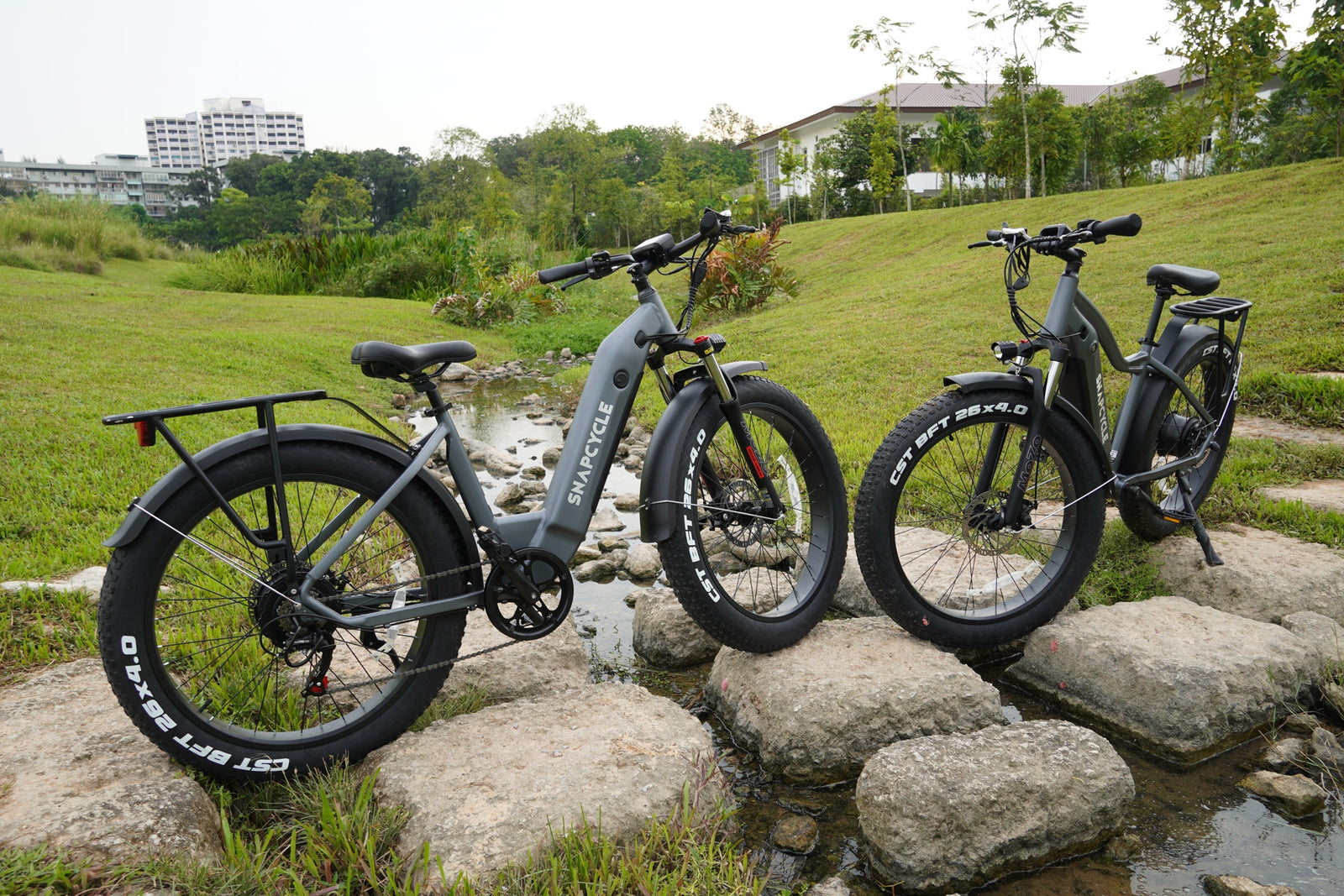There's no simple "yes" or "no" answer to whether fat tire ebikes are harder to pedal. The reality is more nuanced. Fat tire electric bikes present a trade-off: they offer exceptional capabilities in certain areas but require more effort in others. While they excel on challenging terrains like sand, snow, and rough trails, the very features that make them so capable off-road also contribute to increased pedaling difficulty. Understanding these trade-offs is crucial for anyone considering a ebike with fat wide tires.
3 Main Reasons Fat Tire Bikes Are Harder to Pedal
Fat tire electric bikes, while offering a unique riding experience and tackling diverse terrains with ease, present a distinct challenge when it comes to pedaling. Several factors contribute to this increased difficulty, making them less ideal for some riders, particularly those prioritizing ease of pedaling. Understanding these reasons is key to making an informed decision when choosing an ebike.
No. 1: Fat Tires Make the Ebike Heavier
The sheer size and volume of fat tires contribute significantly to the overall weight of the bike. This added weight makes it more difficult to pedal, especially for individuals who are smaller or less physically strong. Slim and smart riders, including young boys and girls, may find the extra weight particularly challenging, especially when riding uphill or accelerating from a stop. This increased weight can also impact the bike's handling and make it feel less nimble.
No. 2: Increased Rolling Friction of Fat Tires
Due to their wider contact, these tires patch with the ground, and experience greater rolling friction compared to traditional tires. This increased friction requires more effort to overcome, effectively slowing down the bike and making it harder to pedal. While this increased friction is beneficial for traction on loose surfaces, it becomes a disadvantage when pedaling on paved roads or other smooth surfaces where less rolling resistance is desired for efficient movement.
No. 3: Limited Maneuverability of Fat Tires
Although these tires excel in providing stability and traction on rough terrain, their width can limit maneuverability, especially in tight spaces. Navigating through narrow pathways, crowded areas, or technical trails can be more challenging with fat and wide tires. This reduced maneuverability can make pedaling more difficult as riders may need to exert more effort to control the bike and avoid obstacles, especially when combined with the added weight and rolling resistance.
You may also like to read: How To Raise e-bikes Handlebars? 3 Expert ways
Common Riding Experiences with Fat Tire Ebikes
Riding a fat tire electric bike is a unique experience, often described as feeling like gliding over the terrain. The wide tires provide exceptional traction and stability, absorbing bumps and vibrations for a smoother, more comfortable ride, especially on uneven surfaces. Riders often report a sense of increased confidence, particularly when navigating challenging terrains like sand, snow, or gravel. The larger contact patch of the tires also offers a more planted feel, enhancing control and balance, which can be particularly beneficial for less experienced riders or those seeking extra stability.
Who is Ideal for a Fat Tire Ebike?
Fat tire ebikes are a popular choice for adventurers and outdoor enthusiasts who frequently ride on varied terrains. They are ideal for individuals who want a single bike that can handle everything from paved roads to off-road trails. Hunters, anglers, and campers often appreciate the ability of fat tire ebikes to traverse rough terrain and access remote locations. Riders who live in areas with snow or sand also find fat tire ebikes invaluable for year-round commuting and recreation. While experienced cyclists enjoy the challenge and versatility of fat tire ebikes, beginners also find them appealing due to the enhanced stability and ease of control they offer. Essentially, anyone who values stability, traction, and the ability to explore diverse landscapes can benefit from a fat tire electric bike.
Step Thru Ebike Vs Fat Tire Ebike: Which You Should Buy?
Choosing the right ebike depends entirely on your individual needs, riding style, and preferences. There's no one-size-fits-all answer. Do you prioritize easy access and comfortable commuting, or are you seeking adventure on challenging terrains? This comparison of step-thru ebike and fat tire ebikes will highlight their key differences, empowering you to make an informed decision. From frame design and tire type to riding position and price, we'll explore the 12 crucial points that will help you choose the perfect ebike for your lifestyle.
1. Frame Design of Fat Tire Ebikes:
Step thru electric bike prioritizes accessibility. Their defining feature is the low or absent top tube, allowing riders to easily step through the frame rather than swinging a leg over. This design is beneficial for those with mobility limitations, shorter riders, or anyone who prefers a more convenient mounting and dismounting process. Wide tire bikes, on the other hand, typically feature a more traditional diamond-shaped frame, although some manufacturers offer slightly modified versions to accommodate the wider tires. The focus here is on strength and stability, necessary for the demands of off-road riding.
2. Fat Tire Ebikes are easy to mount and dismount:
The step-thru design excels in ease of mounting and dismounting. Riders simply step through the open frame, eliminating the need to lift a leg high, which is a significant advantage for individuals with joint pain, limited flexibility, or balance issues. These ebikes with their higher top tubes, require riders to swing a leg over the frame, a more traditional approach that can be challenging for some.
3. Rider may have to lean forward in Fat tire ebike:
Step thru electric bike often promote a more upright and relaxed riding posture. The frame design often allows for a more comfortable reach to the handlebars, reducing strain on the back and wrists. Fat tire ebikes can also offer a relatively upright position. Still, the wider tires and intended use on varied terrain can influence the rider to lean forward slightly more for better control, especially on uneven trails.
4. Terrain:
Step thru electric bike are best suited for paved roads, bike paths, and other smooth surfaces. While they can handle some light gravel or packed dirt, their narrower tires and frame design aren't optimized for rough terrain. Fat tire ebikes, however, are designed to excel on a wide range of surfaces, including sand, snow, mud, gravel, and challenging off-road trails. Their wide tires provide exceptional traction and stability.
5. Tires Sizes and Contact Area with The Earth:
Step thru electric bike typically uses standard and more efficient ebike tires, which are narrower and designed for efficiency on paved surfaces. Fat tire ebikes, as the name suggests, are equipped with extra-wide tires, usually 4 inches or more in width. These large tires offer increased contact area with the ground, leading to better traction and a more cushioned ride.
You may also like to read: Let’s Calculate How Many Amps A 500 Watt Ebike Draw
6. Traction on both the smooth and rough surfaces:
The difference in tire width significantly impacts traction and stability. Step thru electric bike, with their narrower tires, have less traction on loose or uneven surfaces, making them more prone to slipping or losing control in challenging conditions. Fat tire ebikes, thanks to their wide tires, offer superior traction and stability, allowing riders to confidently navigate sand, snow, and other difficult terrains.
7. Step Thru Ebikes Offers More Comfort:
Both types of bikes can be comfortable, but the source of comfort differs. Step thru electric bikes often prioritize comfort through their upright riding position, while fat tire bikes achieve comfort through their wide tires, which absorb bumps and vibrations much more effectively than narrower tires, leading to a smoother ride, particularly on rough terrain.
8. You can get more speed with Step thru ebike:
On paved surfaces, Step thru electric bikes generally have a speed advantage. Their narrower tires create less rolling resistance, allowing for greater efficiency and higher speeds with the same amount of effort. Fat tire bikes, due to the increased rolling resistance of their wider tires, tend to be slower on paved roads.
9. Ease in Navigation:
Step thru electric bikes, being lighter and often having a more compact frame, tend to be more agile and maneuverable, making them easier to navigate through tight spaces and traffic. Fat tire bikes, due to their larger tires and often sturdier frames, can feel less agile and more bulky, especially in confined areas.
10. Weight Of eibikes:
Step thru electric bike are usually lighter than fat tire bikes. The wider tires and reinforced frames of fat tire ebikes add weight, making them more challenging to lift, transport, and store.
11. Price OF both ebikes:
Step thru electric bike are often more affordable than fat tire ebikes. The specialized components of fat tire ebikes, such as the tires, rims, and frames, contribute to their higher cost.
12. Where These ebikes will suit you more?
Step thru electric bike are ideal for commuting, running errands, and leisurely rides on paved surfaces. They are particularly well-suited for riders who prioritize ease of use, comfort, and practicality. Fat tire ebikes are best for off-road adventures, exploring diverse terrains, and riding in challenging conditions like sand, snow, or mud. They are a good choice for riders who prioritize stability, traction, and the ability to handle a wide range of surfaces.
FAQs
What is the average price of ebike fat tires?
Fat tire prices vary based on size, brand, and quality, typically ranging from $50 to $150 per tire. Expect to pay more for high-performance or specialized tires.
Where to get high-quality fat tire ebikes?
Reputable local bike shops are a great starting point, offering expert advice and test rides. Snapcycle also provide a wide selection, but be sure to research brands and read reviews before purchasing.
Are fat tire bikes good for snow?
Yes, fat tire ebikes excel in snowy conditions. Their wide tires provide excellent traction and stability, making winter riding safer and more enjoyable.
Are fat tire ebikes good for beginners?
Yes, the extra stability offered by fat tires can make ebikes easier to handle for beginners. The increased traction and control can boost confidence, especially on uneven terrain.
What are the different types of fat tire ebikes?
Fat tire electric bikes come in various styles, including hardtail, full-suspension, and folding ebike models. Each offers different features and is suited to specific riding styles and terrains.

